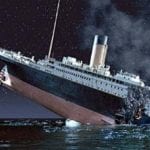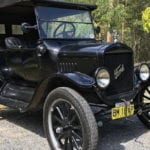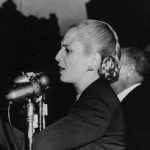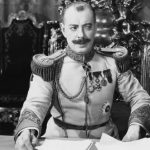 Weird Stuff
Weird Stuff  Weird Stuff
Weird Stuff  Our World
Our World 10 Ways Your Christmas Tree Is More Lit Than You Think
 Movies and TV
Movies and TV The 10 Coolest Stars to Set Sail on The Love Boat
 History
History 10 Things You Didn’t Know About the American National Anthem
 Technology
Technology Top 10 Everyday Tech Buzzwords That Hide a Darker Past
 Humans
Humans 10 Everyday Human Behaviors That Are Actually Survival Instincts
 Animals
Animals 10 Animals That Humiliated and Harmed Historical Leaders
 History
History 10 Most Influential Protests in Modern History
 Creepy
Creepy 10 More Representations of Death from Myth, Legend, and Folktale
 Technology
Technology 10 Scientific Breakthroughs of 2025 That’ll Change Everything
 Weird Stuff
Weird Stuff Ten Bizarre Facts About The Doge Meme
 Our World
Our World 10 Ways Your Christmas Tree Is More Lit Than You Think
 Movies and TV
Movies and TV The 10 Coolest Stars to Set Sail on The Love Boat
Who's Behind Listverse?

Jamie Frater
Head Editor
Jamie founded Listverse due to an insatiable desire to share fascinating, obscure, and bizarre facts. He has been a guest speaker on numerous national radio and television stations and is a five time published author.
More About Us History
History 10 Things You Didn’t Know About the American National Anthem
 Technology
Technology Top 10 Everyday Tech Buzzwords That Hide a Darker Past
 Humans
Humans 10 Everyday Human Behaviors That Are Actually Survival Instincts
 Animals
Animals 10 Animals That Humiliated and Harmed Historical Leaders
 History
History 10 Most Influential Protests in Modern History
 Creepy
Creepy 10 More Representations of Death from Myth, Legend, and Folktale
 Technology
Technology 10 Scientific Breakthroughs of 2025 That’ll Change Everything
10 Times the Scots and the English Met in Deadly Pitched Battle
In modern times, the English and the Scots have found a way to live peacefully as neighbors. But jump back a handful of centuries, and that was often very far from the case. In fact, it was commonplace for the two nations to settle their differences with extreme violence on the battlefield. Deadly conflict became less common after the union of the crowns in 1603 and the amalgamation of the parliaments in 1707, although it didn’t stop altogether. Read on to find out about ten times the Scots and the English met in deadly pitched battle.
Related: Top 10 Poorly Planned Battles
10 Battle of Stirling Bridge, 1297
Edward I of England claimed overlordship of Scotland in 1296 after defeating the Scots led by King John Balliol at the Battle of Dunbar, sparking the First Scottish War of Independence. But that left the field clear for a certain Scots nobleman, William Wallace. He mustered an army that met the English forces headed by John de Warenne, 7th Earl of Surrey, at the strategic city of Stirling on the River Forth. Wallace’s men occupied land to the north of the river while de Warenne’s force encamped on the southern bank.
Only one narrow wooden bridge spanned the river, and an outnumbered Wallace bided his time, awaiting an English advance. The Scots had most to fear from the English heavy cavalry, but the horsemen could only cross the timber bridge two abreast. On a September morning, the English horsemen began to move over the bridge. Once the cavalry was north of the Forth and separated from the rest of the English troops, Wallace attacked. His infantry, armed with 12-foot pikes, massacred the English knights and, demoralized, the remainder of the English army retreated south. Victory was Wallace’s. [1]
9 Battle of Falkirk, 1298
Although his army had been comprehensively defeated at the Battle of Stirling Bridge, as far as Edward I was concerned, that was not the end of the matter. That was particularly so because a victorious Wallace had led his men on a raid into the north of England. Infuriated, Edward assembled a 15,000-strong army, which included a formidable 2,500 mounted knights and many archers with their fearsome longbows.
As the English army marched north with Edward at its head, Wallace’s force, with about 1,000 knights and 5,000 infantry, retreated before them, adopting scorched earth tactics. Finally, in July 1298, the inevitable confrontation came at the central Scottish town of Falkirk. The Scots occupied a promising position on a hillside with an impenetrable marsh to their fore. Wallace hoped his men, with their long pikes, would defeat any cavalry English charge. At first, this tactic succeeded, but then Edward ordered his archers into action, and their deadly fire broke the Scottish formations, giving victory to the English.[2]
8 Battle of Bannockburn, 1314
After Wallace’s defeat at Falkirk, his status as a Scottish leader collapsed. Captured in 1305, he was hung, drawn, and quartered in London as an example to other rebellious Scots. Despite this gruesome fate, another Scottish leader emerged committed to freedom for his nation. He was Robert the Bruce. His antagonist was Edward I’s son, Edward II.
Prior to the Battle of Bannockburn, the rebellious Scots had already cleared their nation of English strongholds apart from the daunting Stirling Castle. Bruce’s 7,000 men had the castle under siege, and Edward moved south to relieve Stirling at the head of a 16,000-strong English force. The battle began at a hunting reserve outside the city, with Edward’s knights repelled by the Scottish pikes.
Fighting continued into a second day, with the Scots holding fast against multiple cavalry charges. Many of Edward’s knights fell into defensive ditches the Scots had prepared, and in the ensuing confusion, Bruce’s men routed the English. This battle brought the First War of Scottish Independence to an end, although a formal peace treaty wasn’t signed until 1328. Scotland had defended her freedom.[3]
7 Battle of Halidon Hill, 1333
Although Scotland had emerged victorious from the First War of Independence, that was far from the end of conflict with its southern neighbor. Just a few years after the end of the First, the Second War of Independence got underway during the reign of Edward III. Scotland was then ruled by the Regent Sir Archibald Douglas on behalf of King David II, who was still just a boy. Edward Balliol, a would-be usurper of David, allied with Edward III to try to win the Scottish crown.
The English forces, led by Edward himself, marched on the fortified Scottish town of Berwick-Upon-Tweed, which lies right on the Scottish border. Edward’s men laid siege to Berwick, and Douglas led a Scottish force to the town, aiming to lift the siege. The English army took a commanding position at the top of Halidon Hill, a couple of miles from the town.
Below them was marshy ground and it was this that the Scots were forced to cross before an uphill attack on the English. The English archers wreaked havoc among their opponents, and the Scottish army was roundly defeated with great loss, including Douglas. Berwick was lost to Scotland.[4]
6 Battle of Otterburn, 1388
For some years, there was an uneasy truce between the Scots and the English, but this came to an end in 1384 after the Scottish King Robert II failed to make the agreed-upon ransom payments to England’s Richard II. Both sides began to raid their neighbor’s territory, and in 1388, the Scots attacked England both along the border and in Ireland. An army led by James, Earl of Douglas, headed south into eastern England, plundering and burning as they went. An English force under Henry “Hotspur” Percy marched to meet the Scottish raiders.
After indecisive skirmishes around the Northumbrian city of Newcastle-Upon-Tyne, Douglas began to retreat northwards, pursued by Percy’s men. The English caught up with the Scots about 30 miles northwest of Newcastle near the town of Otterburn. Percy made a surprise attack, which caught Douglas’s men completely off guard. Even so, the Scots quickly organized themselves and defeated the English after bloody fighting. Douglas himself was killed in the battle, and Percy was actually captured by the Scots. [5]
5 Battle of Flodden, 1513
In 1513, Henry VIII was on the English throne, and James IV ruled Scotland. Although James was actually married to Henry’s sister Margaret Tudor, relations between the two were at breaking point because Scotland was allied to England’s deadly enemy France. Henry invaded France in 1513, and the French called on James to attack England in retaliation, which he duly did. With French military and financial help, James marched south. Meanwhile, Thomas Howard, Earl of Surrey, mustered an army of some 26,000 at Alnwick in England’s north-east.
The two armies, Scotland’s about 34,000 strong, met at Flodden, not far south of the Scottish border. The Scottish artillery was dug in facing south, so Surrey marched his men to the northeast of the Scots position, allowing him to attack James from the rear. But James spotted Surreys’ movement and turned his forces to face the attack. Even so, Surrey routed the Scots, slaughtering as many as 10,000, including nine earls, 13 barons, and James himself, with English losses numbering around 4,000. James IV was the last British monarch to die in battle.[6]
4 Battle of Haddon Rig, 1542
Henry VIII was still on the English throne in 1542, but the Scottish ruler was now James V. However, nothing had changed in international politics since Flodden nearly 30 years earlier. England was still at loggerheads with France, and Scotland maintained their alliance with the French, much to Henry’s annoyance. Henry claimed overlordship of Scotland and ordered James to London. The Scottish King refused, fearing, likely with some justification, that he would be taken prisoner and held hostage.
Henry decided to punish James’s defiance by invading Scotland. Sir Robert Bowes, commander of the north-eastern border region of England, marched north and set up camp at Haddon (sometimes Hadden) Rig near the Scottish abbey town of Kelso. The English filled their time with looting and pillage in the local area.
A Scots force commanded by George Gordon, Earl of Huntly, approached Haddon Rig while a forward troop of 2,000 under experienced campaigner Sir Walter Lindsay went ahead. Lindsay’s men attacked the encampment, scattering the defenders. The full Scottish force now pursued the English, and in the ensuing rout, Bowes and some 500 of his men were taken prisoner.[7]
3 Battle of Dunbar, 1650
The Scots were appalled by the beheading of Charles I, King of both England and Scotland, in 1649, and when his son, also Charles, landed in Scotland the following year, supporters gathered to him. The English feared that this event would most likely turn into an invasion attempt on England and decided to act first. Meanwhile, Charles mustered an army led by Sir David Leslie, a highly experienced commander. Oliver Cromwell, not yet England’s leader but already a senior general, assembled a 15,000-strong force that marched north.
Cromwell seized the port town of Dunbar on Scotland’s south-east coast while Leslie based his troops behind the fortifications of Edinburgh, some 30 miles distant from the English force. In August, Leslie, whose force numbered some 25,000, decided the time was ripe to surround Cromwell’s men at Dunbar. Cromwell could have retreated by sea but elected to stand and fight. The English launched an attack with devastating effect. The Scots suffered heavy casualties, and the battle ended in a decisive victory for Cromwell, who now marched to Edinburgh and captured the castle there.[8]
2 Battle of Prestonpans, 1745
In the Glorious Revolution of 1689, James II of the Stuart dynasty lost the British throne and was replaced by William of Orange. However, claiming to be the rightful king, James’s son, James Francis Edward Stuart, tried to seize the British crown back with a landing in Scotland in 1715. That attempt was crushed. But in 1745, his son Charles Edward Stuart, best known as Bonnie Prince Charlie, landed in northern Scotland to try again to restore the House of Stuart to the British throne with the help of his supporters, the Jacobites.
Charles raised a 3,000-strong force of mostly Highland warriors, and they marched on Edinburgh, where they took the city unopposed. A British army, some 3,000 strong, under the command of General Sir John Cope, had failed to stop the Jacobites on their march south and now occupied a position at Prestonpans about 10 miles east of Edinburgh on the coast of the Firth of Forth. The Highlanders launched one of their legendary and terrifying charges, and Cope’s men were soon overwhelmed. The Jacobites had prevailed.[9]
1 Battle of Culloden, 1746
After the Jacobite victory at Prestonpans, Bonnie Prince Charlie led his men south into England, reaching as far as the city of Derby in the Midlands, just 125 miles north of London. But that was as far south as the Jacobites got before deciding to retreat north for fear of being trapped by government forces. Another factor in the retreat was the fact that few people, even in southern Scotland, had rallied to the Jacobite cause.
By April, the Jacobites were back in northern Scotland and had decided to make a stand at Culloden, near the city of Inverness. By this stage, Charles’s Highland army was in a poor state, exhausted, and lacking both food and money. The government forces, on the other hand, were well-provisioned and led by an experienced general, the Duke of Cumberland.
The battle commenced with an artillery exchange, and then the Highlanders made their charge. They were defeated within an hour by a combination of British bayonets and deadly fire. It was the end of the Jacobite dream and the last pitched battle on British soil.[10]








